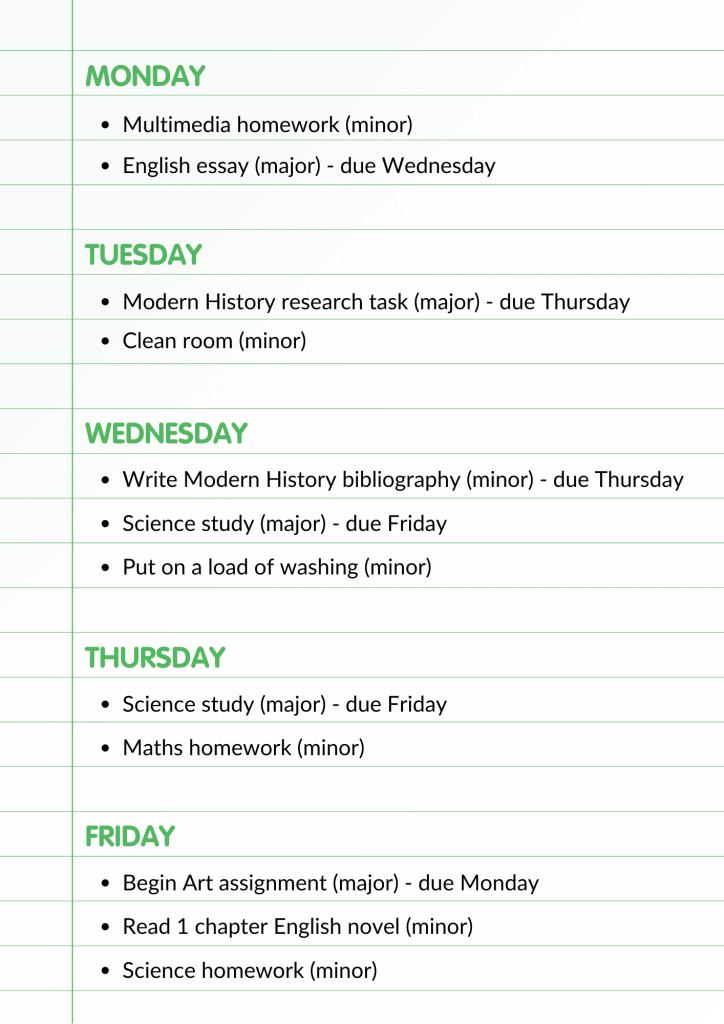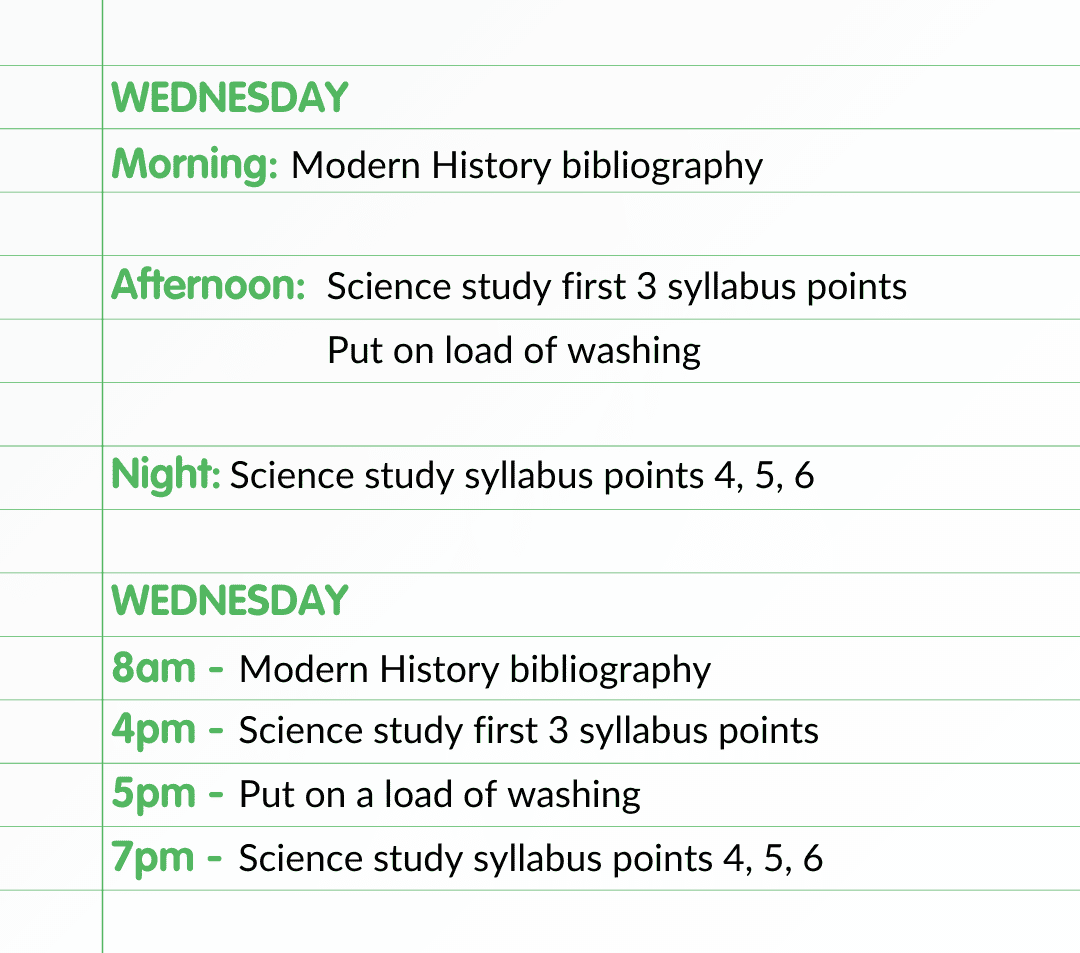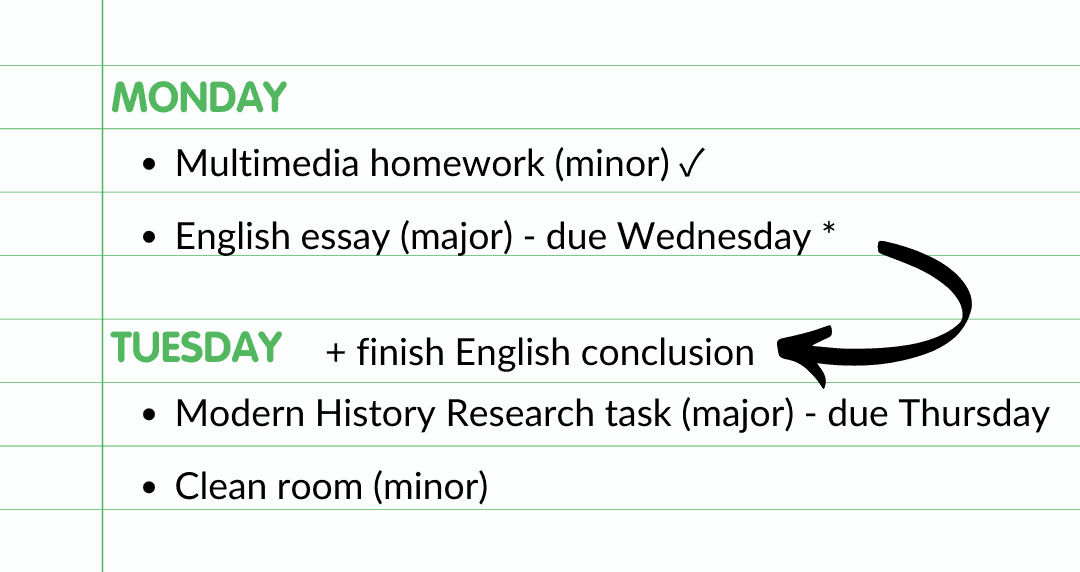I remember most of my HSC year in the form of little to-do lists jotted down on brick pink post-it notes. They were usually short, badly organised and I rewrote them at least 3 times a day, but hey – they were still effective to-do lists, right?
Wrong!
When it comes to writing to-do lists there are heaps of ways to go about it, but for awesome, effective ones you need to know how to do them right. This article will teach you exactly how to make effective to-do lists so that not only do your lists look way better, you’ll actually get things done!
Let’s get into these 5 simple steps!
Step #1: Make a Task List
Step #2: Digital or Traditional?
Step #3: Make a Simple Weekly List
Step #4: Daily To-Do Lists
Step #5: Manage Your Tasks
Step #1: Make A Task List
This doesn’t mean just jumping into your to-do list – that part will come later. For now you want to jot down all the tasks that you need to get done in a certain time frame and when each task is due.
Usually a week works best, but some people go for fortnightly or even monthly tasks lists too. Just try not to bite off more than you can chew!
Now I hear you ask, “Okay, but what kind of tasks should be on this list? Everything? Just school work?” Don’t fret! Because this is your own list — you can include whatever task you think are important, but some popular ones are:
-
- Homework
- Exam study
- Assignments
- Extra-curricular tasks
- Chores
Anything you need to get done is fair game, so fill the list with what you think is important. According to Harvard University, “The effect of goal setting on achievement depends on your commitment to that goal.” So, if you know there’s something you need or want to get done, stick it on this list!
Here’s what a week’s task list may look like:
Notice that two tasks don’t have due dates, meaning that you’ll be able to fit them in around the other tasks later on.
Give it a try: grab a blank scrap of paper and quickly jot down the top 10 tasks you want to get done in the next 7 days! If you think of more that 10 things feel free to keep going.
Step #2: Digital or Traditional?
Just like with study notes there’s the questions of whether to make your to-do lists on a computer or by hand. As usual there are people who swear by each and others who say that it makes no difference, so let’s have a quick look at the benefits of each to help you decide which to-do lists are more effective for you.
Digital Lists
-
- Quick and easy to edit
- Automatically neat and formatted
- Keep them on your phone
- Heaps of great apps for to-do lists
Traditional Lists
-
- More personalised
- Try fun coloured pens and paper
- Physical – stick it on your wall by your desk!
Generally it’s a personal choice, but in today’s world of technology, having digital copies of your to-do lists is super convenient. Plus you won’t accidentally stick it in the recycling! As one student said, “In this digital age there are plenty of apps to help you.” (Stephanie, 84 ATAR).
Speaking of apps, here are my top 3 free ones to try out:
Any.Do – Clean and simple, plus you can add reminders! Works on iOS, Android and Google Chrome, so you can link your phone and laptop.
Wunderlist – Really pretty, plus you can add sub-tasks, repeated events and notes. Plus it works on iOS, Android, Windows, the web and even Kindle. Elizabeth swears by it!
Todoist – Nice minimalist look, plus it syncs with the Cloud (though I admit I still don’t totally understand the Cloud). Works on the web, Android, iOS, Windows, Chrome and Firefox!
If traditional lists are more your thing though, there are some fun DIY styles you might like to try. Check them out here!
Step #3: Make A Simple Weekly List
Here’s where we get to proper effective to-do listing! Essentially we’re making a simplified list of what needs to be done in the coming week. If you made a week-based task list in the first step this will just be a case of re-organising it. If you made a longer list at first, focus now on what you need done in the next 7 days.
Plan out what tasks you need to complete and how you should be prioritising them.
For example, studying for an assignment would be more important than doing class homework, and a task due on Thursday comes before one due on Friday.
If two tasks seem equally balanced also take into consideration how long it will take you to do them. Say you have an English Essay and Studies of Religion Speech due on the same day – you know that practicing your speech will probably take longer, so prioritise it (but get both done!).
Generally, prioritising just means putting it at the beginning of the week on your list.
There’s a rule called the Pareto Principle that says that usually 20% of your work provides 80% of your results. This means that focusing on and prioritising the really important 20% of your tasks will make sure that 80% of your results are awesome!
Next you want to figure out what tasks you need to be working on each day. Some tasks may take multiple days, others only a few hours – these are major versus minor tasks. Generally you want to be looking at a 1:2 major to minor ratio – for every major task on a day you’ll want to complete 2 minor tasks.
For example, your day may look like this:
-
- Edit Modern History assignment (minor)
- Write English essay (major)
- Make Science bibliography (minor)
This way you won’t end up trying to get a whole bunch of major tasks done on one day! Of course, because of how you prioritise your list, some days may only have one or two tasks, and others may have a lot of minor tasks (usually towards the end).
Here’s an example of how your list could look:
I haven’t included the weekend, but it’s best to plan your tasks for Saturday and Sunday as well.
Give it a try: using the task list you made in step one, quickly prioritise each task (give them a number from 1-10 with 1 being most important). Then jot down what your week list might look like.
Step #4: Daily To-Do Lists
Finally there! Now that we know exactly what we have to do, when we want to do it and what’s most important it’s easy to create detailed daily to-do lists. Basically what you do is sit down each night and make a detailed list for what you want to get done the next day.
“I find writing a to do list every day a fantastic way to ensure I am on top of things.” – Guddu, 88.2 ATAR
Using your week list, figure out what tasks you want to get done and decide when in the day you’re going to do them. I like to work in sections of morning, afternoon and night, mainly because you’re probably going to be at school for the middle of the day!
For the major tasks it’s also a good idea to break them down into smaller tasks or sections, that way you can assign pieces to different time slots.
Some people like to go a step further and plan exactly what time they want to start (and sometimes even finish) a task. This can be very useful for planning ahead, especially if you have a busy schedule, but remember that the times you’re setting are more guidelines than rules.
If one task takes you longer than you expected, or you start another task an hour late it’s okay! Just work on finishing what you can and try not to stress too much.
Here’s what one day might look like in each style:
Give it a try: using one of the days from your week list jot down a day to-do list in whichever style you prefer. Let us know in the comments which style you used – morning/afternoon/night or exact times?
Step #5: Manage Your Tasks
This is the fun part – you get to tick off what you’ve done! At the end of each day when you go to write the next day’s to-do list, revisit your week list.
Tick off whichever tasks you completed and put an asterisk next to any you didn’t finish or didn’t get to. This way you know exactly what you still have left to work on and can work to fit it in.
Most people (especially those working digitally) choose to edit their week lists as they go, rearranging tasks based on what didn’t get done or new tasks arising. This is a good way to stay on top of things and keep your week list up to date.
Other people prefer to simply add leftover or new tasks straight into their daily to-do lists – I warn against this! While it seems like a more direct option, this method makes it way too easy to forget about leftover tasks along the line. Unless you have a perfect memory, stick to revising your week list as you go.
Here’s an example of how you might revise your week list.
What Next?
Now that you know exactly how to make and maintain effective to-do lists it’s up to you to get into it! Make your task lists, prioritise them into weekly lists and then break them down day by day into awesome little to-do lists. Studies say that it takes 7 days to form a habit, so once you’ve worked through one week of making daily to-do lists you’ll be totally in the habit.
You don’t need to make daily to-do lists for every single day of your school year – you would go crazy! These lists are best for when you have a lot going on, you’re coming up on exam time or you simply need to pull your socks up when it comes to getting things done!
And remember, these lists are by you and for you. If you want to add things here and there or change the way you do a certain step, it’s totally okay! Whatever is going to help you get the job done and is most effective for you is the only “right” way to do things.
Looking for some extra help with your HSC studies?
We pride ourselves on our inspirational HSC coaches and mentors!
We offer tutoring and mentoring for Years K-12 in a variety of subjects, with personalised lessons conducted one-on-one in your home or at our state of the art campus in Hornsby!
To find out more and get started with an inspirational tutor and mentor get in touch today!
Give us a ring on 1300 267 888, email us at [email protected] or check us out on Facebook!
Maddison Leach completed her HSC in 2014, achieving an ATAR of 98.00 and Band 6 in all her subjects. Having tutored privately for two years before joining Art of Smart, she enjoys helping students through the academic and other aspects of school life, even though it sometimes makes her feel old. Maddison has had a passion for writing since her early teens, having had several short stories published before joining the world of blogging. She’s currently studying a Bachelor of Design at the University of Technology Sydney and spends most of her time trying not to get caught sketching people on trains.







